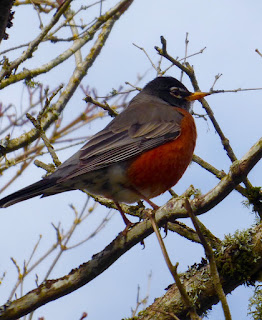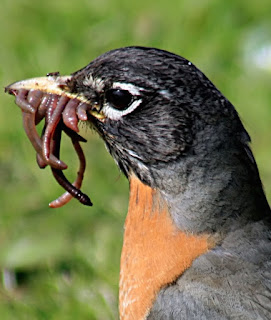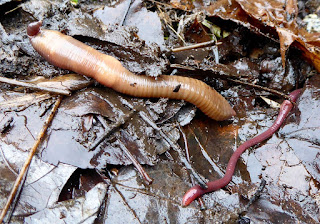 I can’t say I always notice the first robin of spring. All of a sudden there are packs of robins around and I wonder how long they’ve been here.
I can’t say I always notice the first robin of spring. All of a sudden there are packs of robins around and I wonder how long they’ve been here.
This year we’re awash in them. They’ve taken over entire trees and they’re scattered in bright bunches all over the ground. The sun is peeking out, there is the promise of warmth, a loamy fragrance is in the air, daffodils are pushing up, and a young man’s fancy lightly turns to the same thing it was turning to all winter; in short, it’s springtime. And I look out at the robins, and I have the same thought everyone else does: have you ever seen such a collection of fat fucks in all your life?
My goodness, but they’re corpulent. Everywhere you look, a red red robin is blob-blob-blobbing a lawn. It has to be the worms. Our chickadees are stuffed with seeds and look like adorable little Steiff toys, but robins are packing earthworms, and boy do they look it. They’s paunchy. And no wonder. Except for a sparse allotment of random, inconsequential organs, earthworms are just big tubes of goo. And they can be huge, particularly in comparison with a robin. It’s like if you or I ate a sleeping bag filled with pudding.
 The American Robin’s real name is Turdus migratorius, which doesn’t mean what you think it means. Turdus comes from the Latin for “flush.” Sorry, I meant “thrush.” And migratorius is from the Latin for “to go.” Okay, it does mean what you think it means. The robin can have two or three broods of babies per season, building a fresh new nest each time, probably because of the weight gain. The female lays three to five eggs. Amazingly, they’re robin’s-egg blue.
The American Robin’s real name is Turdus migratorius, which doesn’t mean what you think it means. Turdus comes from the Latin for “flush.” Sorry, I meant “thrush.” And migratorius is from the Latin for “to go.” Okay, it does mean what you think it means. The robin can have two or three broods of babies per season, building a fresh new nest each time, probably because of the weight gain. The female lays three to five eggs. Amazingly, they’re robin’s-egg blue.
Robins generally hunt by sight, but presumably they can hear earthworms scootching around below the surface too, and then it’s just stab-and-yank and down-the-hatch. Hard to tell how the earthworm feels about this. I personally know you can cut an earthworm in half with your thumbnail and string it on a fish hook, and both halves continue to visibly object for quite a long time, but they don’t seem to die. They do indeed have a mouth and an anus and those are on opposite ends, so you’d think it would matter. But in fact, the only dead earthworms anyone ever sees are in the form of either dried-up crackers on the sidewalk or robin poop.
They definitely do not appreciate being dry. When they show up in huge quantities on the ground after a rain it’s not because they’re drowning in their little tunnels. They like moisture. They’re just taking advantage of a nice wet situation to make a little better time topside, but it doesn’t always work out for them. They can be stranded on a sidewalk in numbers sufficient to prevent a small, sensitive girl from being able to walk all the way to school, and have to return home in tears just as her mommy was relaxing with Arthur Godfrey and a donut. Or so I’m told.
 There’s not a lot to an earthworm other than the goo, but even the casual observer will have noticed that thick portion that looks like a belt. This is where the sexual parts are kept, and all earthworms have both male and female parts. Even so, they do get together to swap sperm by holding those thick belts close together. The belt is called the “clitellum,” which probably does mean what you think it means. The really cool part is that, after the mating, the clitellum then secretes a whole different layer of goo in a ring around the worm, which the worm dumps sperm and eggs into and then subsequently wriggles out of, as one would expect, since this is the earthworm equivalent of the wet spot. The abandoned ring closes up and becomes a cocoon for the baby worms. For a goo-based life form, it’s right tidy.
There’s not a lot to an earthworm other than the goo, but even the casual observer will have noticed that thick portion that looks like a belt. This is where the sexual parts are kept, and all earthworms have both male and female parts. Even so, they do get together to swap sperm by holding those thick belts close together. The belt is called the “clitellum,” which probably does mean what you think it means. The really cool part is that, after the mating, the clitellum then secretes a whole different layer of goo in a ring around the worm, which the worm dumps sperm and eggs into and then subsequently wriggles out of, as one would expect, since this is the earthworm equivalent of the wet spot. The abandoned ring closes up and becomes a cocoon for the baby worms. For a goo-based life form, it’s right tidy.
This copulatory act would seem to be an opportune time for a robin to get a two-fer, but worms generally mate at night. And the big feathered fatties have to sleep it off sometime.
Actually, the robins don't go anywhere — at least not here in Delaware. We see them all winter, when the weather gets a little bit warmer and the ground softens up. They descend upon lawns and berms everywhere, gobbling up earthworms. Once the weather gets cold and dry again, they are gone. I have heard that they actually hang out in the woods in the winter. Presumably, they have easier access to worms under the leaf rot. I have not witnessed this myself, as I am a big baby about the cold, and do not go on hikes when it's freezing. But they certainly are not commuting from the tropics all winter, fat fucks that they are; all that wingcersizing would make them svelte.
Robins do migrate, following a temperature gradient that is conducive to worm-pulling. That could be east or west or a little south or just about anything. But they don't go flying off to Costa Rica or anything. I'd like to see the fat fucks try.
Our species isn't all that evolved, are we? We have a few masochistic robins that try to spend the winter here. Most of the others with more than two functioning brain cells head south.
It works out. The few that stick around have much less competition for whatever they find. Everyone leaves and a couple of them that spent the morning on the john and missed the announcement look around and say, Huh. This won't be so bad.
So did the fishing with worms come before or after the not being able to go to school because of sidewalk worms?
And I chuckled out loud at "amazingly, they're robin's-egg blue." Out loud! There were a ton of funny lines so how come that one got me? Have you done any research on this?
I never know why anything's funny but sometimes just the stupidest things make me snot myself.
I am absolutely certain that at least once in my younger years, I experienced that same sidewalk worm incident; funny how earthworms don't bother me in the least, these days. Must've been the whole walking-without-squishing-them ordeal!
That is exactly what it was. I didn't feel the same way about mosquitoes.
I went the opposite way – I used to cheerfully put them on the hook to fish when I was quite young; now I can't stand to walk anywhere they are stranded. It's not that worms themselves bother me, because they don't. It is, as you both say, the not wanting to hurt them. I hate walking on the barnacled rocks at the shore for the same reason.
I learned to bait a hook because I wanted to fish, but I still can't step on them, and I hate to walk on barnacles too.
I'm hoping to see worms today, if they didn't all get washed down the drains in our storms yesterday.Or run over and squashed by lost balls flushed out of the golf links.
Wait–did you move to California??
They usually show up at my house in April, then shiver and look accusingly through the window when it snows on them.
They always think it's our fault. Well, it is, a little bit.
Thank you for the science lesson!!
I try.
Gosh you made me laugh! "Amazingly they're robins-egg blue" for some reason that struck me as extremely funny. I didn't know that about the earthworm belt, I assumed that was the stomach part where food was digesting.
I didn't know either. And this has been known a long time. Just imagine how much else we don't know! And people are making POLICY without knowing things. Gad.
"It's like if you or I ate a sleeping bag filled with pudding."–my favorite line—
I think I've kind of done it.
Mmmm, I think I'm gonna try that tonight……
You had me at "flush"!
Ahh, hon, but you're easy!
I kept wondering "what's a binger?" As in Bing Crosby-er. Binger. What goes bing? Oh. Finally got it. Bin-jer. Hah.
No rules in English.
Another informative and snort-worthy post. Now when the fat little buggers show up, I'll be able to impress my friends and family with knowledge. The goo tubes don't show up here in the frozen north until May or so. Right now, all we have are flocks of crows who mock me while I'm out shoveling snow. Cue the violins.
You know what? Most people here don't even have a snow shovel. Coulda used one this year.
We have five, the biggest looks like the front of a bulldozer, with handles. C'mon up and I'll lend you one or five.
I learned just yesterday that there are winter robins and spring robins in Maine. I've always thought a Robin was a Robin. Apparently the winter ones stay here year round and are the plump ones we see in winter and mislead us into thinking we've seen ""the first Robin of spring." The official spring robins are much slimmer. I know autocorrect is capitalizing Robin here, but I'm too lazy to go back and change it.
We had one in our yard so fat his belly brushed the ground when he hopped. I wish I'd gotten a picture of him.
Thank you, your article is very good
viagra asli usa